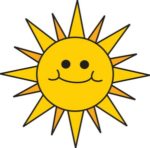 For a long time we have embraced and promoted the Hiker’s Thirteen Essentials as the recommended hiker carry list for use in the White Mountains. This, for those who weren’t aware, goes above and beyond the well-known “Ten Essentials” by adding sheltering material like a bivy or tarp, a partial or full size foam sleeping pad, and sun protection to the list. We felt the latter had enough significance that nowadays it warranted its own list item. Then we started thinking about protection from pests, namely ticks and mosquitoes. We were seriously thinking: is a 14th essential needed? Pest repellent products like sprays and head nets were becoming just as important as hats, glasses, and sunscreen to today’s hiker. But we didn’t like where this was going. Would the list keep growing?! We didn’t want that preferring to stick to just 13 items.
For a long time we have embraced and promoted the Hiker’s Thirteen Essentials as the recommended hiker carry list for use in the White Mountains. This, for those who weren’t aware, goes above and beyond the well-known “Ten Essentials” by adding sheltering material like a bivy or tarp, a partial or full size foam sleeping pad, and sun protection to the list. We felt the latter had enough significance that nowadays it warranted its own list item. Then we started thinking about protection from pests, namely ticks and mosquitoes. We were seriously thinking: is a 14th essential needed? Pest repellent products like sprays and head nets were becoming just as important as hats, glasses, and sunscreen to today’s hiker. But we didn’t like where this was going. Would the list keep growing?! We didn’t want that preferring to stick to just 13 items.
Dropping the Sun from Sun Protection
We decided the best remedy was to modify our recommend 13th item. Instead of Sun Protection we would drop the sun and just call it protection — you’ll now see it listed as Varied Protection, actually. The specifics of what one will define as protection may now be determined by the individual or group leader in such the case, and be based on one or more of several factors:
Factors Determining What Protections are Needed
- Objective and subjective hazards.
- Risk responsiveness and fear.
- Solar intensity and cover.
- Seasonal pest presence and habitat.
- Weather conditions and forecast.
- Time of year, trail, and location.
Some Examples of Protection Items
Based on the categories of protection as defined above, let’s check out some examples within each category.
- Objective and subjective hazards.
- This category might include climbing gear, a helmet, rope, trekking poles, an ice axe, and crampons and other traction aids, all of which help us protect ourselves from certain objective and subjective hazards like falling, or something falling on us, and more. This may include wind hazards, sliding hazards, and more.
- Risk responsiveness and fear
- Our perception plays a big role. Our personal fears may dictate the carry of certain protections. This may include, for example, protection from wildlife encounters with bears or moose, or to be more realistic, run-ins with domesticated dogs who have untrained owners. In such cases protections may include bear spray or perhaps an ultrasonic dog deterrent.
- Solar intensity and cover.
- Being exposed on sunny days, particularly on snowy terrain, or during the height of summer, may warrant to use of sun protection items like zinc oxide and other sunscreen (SPF30+), UV-protective sunglasses or glacier glasses, UV-protective lip balm, long sleeve garments, a floppy hat, even a sunbrella in some cases.
- Seasonal pest presence and habitat.
- Spring is the worst if hiking in pest-heavy areas. It always seems like ticks are their worst after they emerge from their overwintering sites. Then there are black flies, mosquitos, noseeums, deer flies, and more in NH. Protections may include permethrin clothing treatments, DEET repellents, long pants tucked in, gaiters, net gear for head and more.
- Weather conditions and forecast.
- Being prepared means carrying the right gear and wearing/having the right clothing, all of which may be considered protection. The specifics, however, may be determined to a degree by the weather and forecast. On some days, for example, a cotton t-shirt may be carried for cooling, while on other days specialty gear and salves to prevent frostbite may be wanted.
- Time of year, trail, and location.
- Threats to our well-being from which require protection may vary by many factors as already defined. Thus we aren’t adding anything to our list of possible protections, but the time of year, trail, and location (i.e., alpine versus sub-alpine) should be considered and researched if unknown.
Moving forward we hope to succeed in redefining the 13th Essential and we hope you’ll join us by adopting and sharing this change with others. For more about gear, please check out this Gear and Clothing Handout (PDF).
